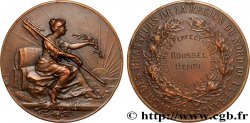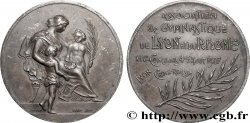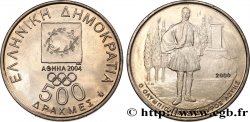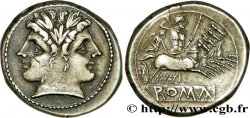fme_957072 - DRITTE FRANZOSISCHE REPUBLIK Médaille, Centenaire de 1789
10.00 €
Menge
In den Warenkorb

Type : Médaille, Centenaire de 1789
Datum: 1889
Metall : Bronze
Durchmesser : 32,50 mm
Stempelstellung : 12 h.
Graveur BARRE Jean-Jacques (1793-1855)
Gewicht : 14,55 g.
Rand lisse
Punze : corne BRONZE
Kommentare zum Erhaltungszustand:
Restes de rouge de frappe. Présence de quelques rayures
N° im Nachschlagewerk :
Vorderseite
Titulatur der Vorderseite REPUBLIQUE FRANÇAISE À L’EXERGUE BRONZE CORNE / SUFFRAGE UNIVERSEL.
Beschreibung Vorderseite Tête à gauche de la république portant dans les cheveux un ruban marqué SUFFRAGE UNIVERSEL, signé BARRE .
Rückseite
Titulatur der Rückseite REPUBLIQUE FRANÇAISE / EXPOSITION UNIVERSELLE // CENTENAIRE / DE / 1789.
Beschreibung Rückseite Légende circulaire ; dans une couronne de chêne et d'olivier sous une étoile rayonnante.
Kommentare
Le poinçon se trouve à l’exergue du droit et non sur la tranche.
Les expositions universelles ont été créées pour présenter les réalisations industrielles des différentes nations. Elles représentaient la vitrine technologique et industrielle des participants, témoignant du progrès au cours de la révolution industrielle. La première exposition universelle s'est déroulée à Londres en 1851.
À l'origine, chaque pays disposait d'un espace réservé dans un pavillon central. À partir de 1867, des pavillons nationaux firent leur apparition. En principe, ils étaient attribués seulement s'il y avait des choses à présenter que le pavillon central ne pouvait accueillir. Ils ne tardèrent pas à se généraliser, les nations exposantes construisant des pavillons typiques de l'architecture de leurs pays.
La compétition était omniprésente dans les expositions universelles, et des concours permettaient aux plus méritants d'obtenir des médailles bénéficiant d'un certain prestige.
De nombreuses réalisations architecturales construites à l'occasion d'expositions universelles sont devenues par la suite des symboles des villes qui les ont abritées : la tour Eiffel à Paris, l'Atomium à Bruxelles, le Space Needle à Seattle, la Biosphère à Montréal.
Enfin, la tenue des expositions universelles a toujours été l'occasion de mettre en place des projets d'urbanisme : construction du métro de Paris en 1900 ou celui de Montréal en 1967, extension du métro de Lisbonne en 1998…
Voir http://fr.wikipedia.org/wiki/Exposition_universelle .
The punch is located at the exergue of the right and not on the edge.
World's Fairs were created to showcase the industrial achievements of different nations. They represented the technological and industrial showcase of the participants, testifying to progress during the industrial revolution.. The first World's Fair took place in London in 1851..
Originally, each country had a dedicated space in a central pavilion. From 1867, national pavilions appeared. In principle, they were only allocated if there were things to be presented that the central pavilion could not accommodate.. They soon became widespread, with exhibiting nations building pavilions typical of the architecture of their countries..
Competition was omnipresent at world fairs, and competitions allowed the most deserving to obtain medals that carried a certain prestige..
Many architectural achievements built for world exhibitions have subsequently become symbols of the cities that hosted them: the Eiffel Tower in Paris, the Atomium in Brussels, the Space Needle in Seattle, the Biosphere in Montreal..
Finally, the holding of universal exhibitions has always been an opportunity to implement urban planning projects: construction of the Paris metro in 1900 or that of Montreal in 1967, extension of the Lisbon metro in 1998… See http://fr. Wikipedia. org/wiki/Exposition_universelle
Les expositions universelles ont été créées pour présenter les réalisations industrielles des différentes nations. Elles représentaient la vitrine technologique et industrielle des participants, témoignant du progrès au cours de la révolution industrielle. La première exposition universelle s'est déroulée à Londres en 1851.
À l'origine, chaque pays disposait d'un espace réservé dans un pavillon central. À partir de 1867, des pavillons nationaux firent leur apparition. En principe, ils étaient attribués seulement s'il y avait des choses à présenter que le pavillon central ne pouvait accueillir. Ils ne tardèrent pas à se généraliser, les nations exposantes construisant des pavillons typiques de l'architecture de leurs pays.
La compétition était omniprésente dans les expositions universelles, et des concours permettaient aux plus méritants d'obtenir des médailles bénéficiant d'un certain prestige.
De nombreuses réalisations architecturales construites à l'occasion d'expositions universelles sont devenues par la suite des symboles des villes qui les ont abritées : la tour Eiffel à Paris, l'Atomium à Bruxelles, le Space Needle à Seattle, la Biosphère à Montréal.
Enfin, la tenue des expositions universelles a toujours été l'occasion de mettre en place des projets d'urbanisme : construction du métro de Paris en 1900 ou celui de Montréal en 1967, extension du métro de Lisbonne en 1998…
Voir http://fr.wikipedia.org/wiki/Exposition_universelle .
The punch is located at the exergue of the right and not on the edge.
World's Fairs were created to showcase the industrial achievements of different nations. They represented the technological and industrial showcase of the participants, testifying to progress during the industrial revolution.. The first World's Fair took place in London in 1851..
Originally, each country had a dedicated space in a central pavilion. From 1867, national pavilions appeared. In principle, they were only allocated if there were things to be presented that the central pavilion could not accommodate.. They soon became widespread, with exhibiting nations building pavilions typical of the architecture of their countries..
Competition was omnipresent at world fairs, and competitions allowed the most deserving to obtain medals that carried a certain prestige..
Many architectural achievements built for world exhibitions have subsequently become symbols of the cities that hosted them: the Eiffel Tower in Paris, the Atomium in Brussels, the Space Needle in Seattle, the Biosphere in Montreal..
Finally, the holding of universal exhibitions has always been an opportunity to implement urban planning projects: construction of the Paris metro in 1900 or that of Montreal in 1967, extension of the Lisbon metro in 1998… See http://fr. Wikipedia. org/wiki/Exposition_universelle








 Berichten über einen Fehler
Berichten über einen Fehler Die Seite drucken
Die Seite drucken Teilen meiner Auswahl
Teilen meiner Auswahl Stellen Sie eine Frage
Stellen Sie eine Frage Einlieferung/Verkauf
Einlieferung/Verkauf
 Details
Details















